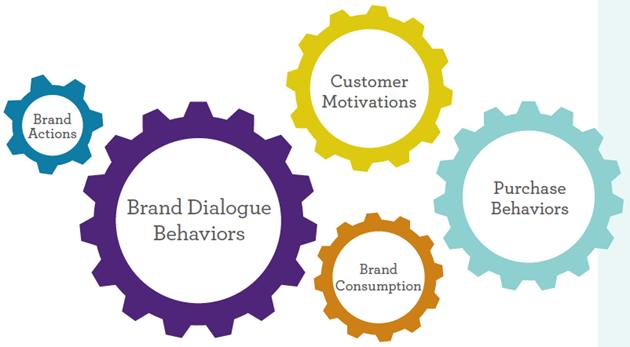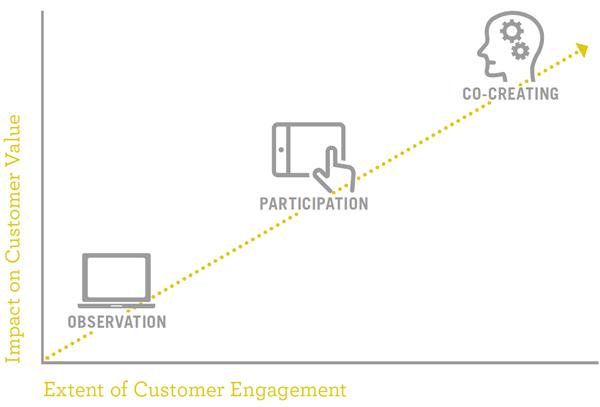To understand how consumers learn about and take actions related to brands, for more than a century marketers have relied on the Attention-Interest-Desire-Action (AIDA) model, developed by Elias St. Elmo Lewis in 1902.
However, the growing influence of the consumer's voice in an always-on digital environment has made obsolete many of the assumptions that underlie that funnel-based view of how consumers and brands engage with each other.
Among the obsolete assumptions about the funnel are the following:
- Engagement is a linear process with a distinct beginning and end.
- Communications are initiated and controlled by the brand.
- The only communications that influence the purchase are between the consumer and the brand.
If consumer engagement can no longer be explained by the brand-managed funnel, what construct accurately depicts the way that engagement occurs? And what types of engagement has the biggest impact on customer lifetime value?
Northwestern University's Spiegel Research Center set out to answer those questions, and the findings of its study have powerful implications for marketers.
Introducing the Consumer Engagement Engine
Northwestern's research showed that engagement in today's digital communications ecosystem works not like a funnel but like an engine where brands and consumers are synergistically interacting with each other in new ways that can have a powerful impact on customer value.

Although the Consumer Engagement Engine differs from the traditional funnel in many ways, these five characteristics are particularly important to marketers looking to engage with consumers in relevant and valuable ways:
- The engine is elegant. It's made of five interlocking components: brand actions, customer motivations, purchase behaviors, brand consumption, and brand dialogue behaviors. Consumers are constantly being influenced by messages from friends, social networks, strangers, the media, and intermediaries—messages that are sent and delivered across numerous platforms and devices.
- There is no on/off switch. Unlike the funnel, which represents engagement as a linear process with a beginning and an end, the engine reflects the always-on state of engagement. Unlike the funnel's "end," the purchase is often the catalyst for the start of new and enhanced levels of engagement. The engagement engine is in perpetual motion.
- Brand actions are just one of the cogs. The brand no longer controls when and how consumer engagement occurs. Today, customers and other actors are just as likely as marketers are to initiate brand-related communication. Brands are moving from being broadcasters to being listener-responders.
- Users of the brand are vital. Buyers' brand consumption experiences—good or bad—are fuel for sharing. The good ones positively power the engine.
- Brand dialogue behavior is the biggest cog. Our research found that nonpurchase behaviors, or "brand dialogue behaviors" (BDBs), have the greatest impact on future engagement. We uncovered powerful insights about how BDBs are driving customer lifetime value.
Understanding and Ranking Brand Dialogue Behaviors
The research found that the types of engagement that frequently had the greatest impact on consumers were brand dialogue behaviors (BDBs), which can involve consumers, other purchasers, nonpurchasers, and the brand itself.
The research also found that these BDBs currently lack a categorization, taxonomy, or ranking according to the value they create for the brand. Marketers need to better understand the opportunity presented by BDBs, as well as the brand's role in BDBs—a role that involves enhancing the customer experience and listening and responding to the engagements.
BDBs can be categorized into three distinct types, all of which have an increasing degree of interactivity and value for the brand:
- Observation: "Lean back" behavior, when the consumer takes a passive role, such as reading a tweet or looking at a retargeting ad
- Participation: The consumer takes an active role in engaging with the content, such as retweeting or looking up a consumer review of a product
- Co-creation: The consumer creates original content that is relevant to the brand, such as participating in a contest to create a new flavor of potato chips, writing a blog post, or voting in a reality TV show
Northwestern's research found that as consumers engage more actively and in ways that involve relevant interaction with the brand, there is a strong correlation to increasing levels of customer lifetime value.

Revving the Consumer Engagement Engine
Here are five things that that marketers can do to engage with customers in ways that drive customer lifetime value in today's digital ecosystem:
- Adopt the engine: Use the engine framework to better engage and drive value for your brand.
- Map your engagement: Identify where your engagement efforts lie on the brand dialogue behavior hierarchy.
- Invest in your customers: Invest heavily in customer experiences and help this audience become your advertisers.
- Drive relevant engagement only: Stimulate only the types of engagement that creates a relevant connection to the brand.
- Listen and respond: Use social media to be a responder, not just a broadcaster.
As marketers continue to adapt to the opportunities and challenges presented by today's rapidly evolving communications landscape, the Consumer Engagement Engine will be a valuable tool for helping marketers engage with existing customers, prospects, intermediaries, and other actors in ways that create value for the brand.
See this video in which I discuss the findings of the research that led to the development of the Consumer Engagement Engine:
More Resources on Consumer Engagement
Five B2B Customer Engagement LinkedIn Strategies for 2021 [Infographic]
Five Steps to Winning Back Lost Customers by Using Targeted Content




